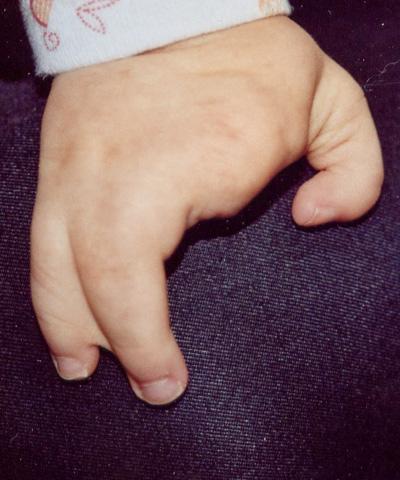
An example of split hand/foot malformation (SHFM). (Source: Wikipedia)
A paper from Amar J. S. Klar, Ph.D., with the RNA Biology Laboratory in NCI’s Center for Cancer Research, has identified a model for DNA research that explains the congenital disorder of mirror hand movements in humans. A mirror movement is when an intentional movement on one side of the body is mirrored by an involuntary movement on the other.
In the words of Donald Court, Ph.D., a colleague in the laboratory, Klar’s model could “[open] a completely novel path to a new and better understanding of a group of abnormalities that plague the human population. It will also mean that investigators will be able to design testable experiments to find and define the gene(s) involved in these defects and start to understand how they function. Experts will then have new ways to think about solving mental and physical abnormalities of human development.”
Klar’s work on recombination and gene silencing for mating-type loci began in 1978 at Cold Spring Harbor Laboratory (CSHL) in Long Island, New York, where he had his first independent faculty position. Through his work with fission yeast, Klar discovered that sister cells are changed in sex type and that the change is strictly based on the double helical structure of DNA at the mating-type locus.
His lab also found that an epigenetic imprint exists on one strand of DNA. Because of this, DNA replication causes the differential regulation of a specific gene in sister chromatids, thereby causing unequal daughter cells to be produced by the parent cell.
The finding led to the discovery of a mechanism that turns the developmental control gene “on” in one chromatid and “off” (silences it) in the sister chromatid. Klar calls this the “monochromatid gene expression mechanism.”
Klar and his team then explored whether this DNA structure–based mechanism operates in diploid multicellular organisms, such as vertebrates. They hypothesized that, for it to do so, the selective chromatid segregation process in mitosis must have evolved in higher organisms to coordinate the distribution of differentiated sister chromatids to specific daughter cells generated for development.
After seeing such an asymmetric cell division in yeast, Klar proposed that this is how body laterality, such as visceral organ and brain hemispheric laterality, is specified in humans. He also advanced the somatic strand-specific imprinting and selective sister chromatid segregation (SSIS) mechanism to explain the congenital disorder of mirror hand movements in humans.
Finally, in a paper published in Developmental Biology, Klar explained the enigmatic genetics of a human limb malformation called the split hand/foot malformation (SHFM).
Through their research, Klar and his team established that DNA’s double-helical structure can differentially regulate the gene expression of a developmental control gene in specific cells during embryogenesis. This mechanism can be used to help explain human body development and the development of congenital disorders such as SHFM, mirror hand movements, and possibly even brain conditions such as schizophrenia and bipolar disorder.
Moving Forward to a New Standard
Of the SSIS model’s acceptance, Klar said that, “being yeast work, heavy in genetics analysis, those studying development in other organisms are mostly unable to understand the genetics logic. Others don’t see the significance of yeast studies—they will only if someone uses our logic for their research on higher organisms. That is what was done in our limb development paper.”
As is often the case in science, Klar’s model is not the only one. Many scientists still prefer a so-called morphogen gradient model, which has been in use since 1952. This model has neither been refuted nor rigorously established, because it is not amenable to experimentally verifiable tests. Even the original proponent of the model, Dr. Lewis Wolpert, discounted it in 2009.
Of the morphogen gradient model, Court says, “[It] has been around for years and has not led to any clear understanding of what kind of genetic mistakes cause the many abnormalities that Klar discusses, much less how they are caused. Amar has specific testable predictions about what the genetic mistakes are… Similar predictions and progress have not been forthcoming for many years by those holding to the morphogen model. It’s the verifiability of the Klar model that sets it apart from the more descriptive morphogen model that others have followed for many years.”
Klar’s current focus is on teaching the world that there is an alternative mechanism of development derived from his team’s yeast work by participating in research conferences, participating in regular RBL meetings, sharing his ideas with colleagues in the lab (and across the NCI at Frederick campus), and publishing further support for the mechanism garnered from diverse organisms.
Outside of work, Klar enjoys tennis and gardening, as well as getting together and traveling with family and friends. Both of his daughters have recently married, and he would like to visit them once he retires in a few years.

